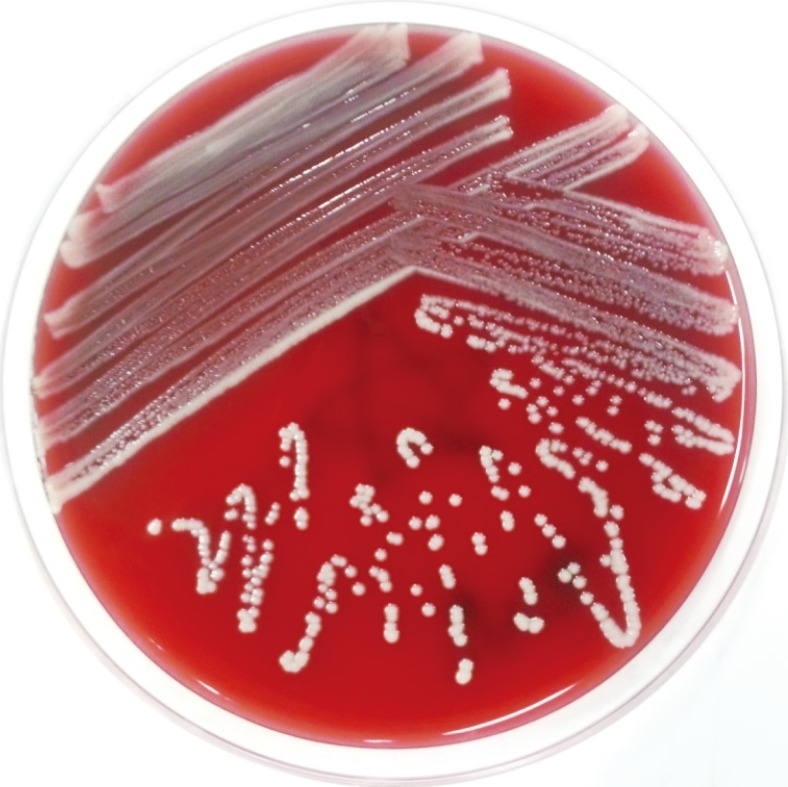Dear Editor
Coryneform bacteria are gram-positive, catalase-positive, usually non-motile, glucose fermentative or non-fermentative, aerobic or facultatively anaerobic rods [1]. Several pathogenic Corynebacterium spp. have been identified, and nosocomial Corynebacterium infection has garnered substantial attention [23]. For example, 281 cases of Corynebacterium infections associated with prosthetic devices, including central venous catheters (CVCs), have been reported [4]. Here, we present the first case in Korea of CVC-related bloodstream infection by C. striatum identified by 16S rRNA and rpoB gene sequencing.
A 51-yr-old man was admitted to our hospital with altered mental status. He had a history of cerebral infarction resulting from hypertension and diabetes mellitus. Initial complete blood count revealed: WBC count, 10.3×109/L; hemoglobin level, 11.6 g/dL; and platelet count, 692×109/L. C-reactive protein (CRP) level was 4.15 mg/dL. He became confused and developed recurrent seizures. Under the diagnosis of status epilepticus, he was treated with infusions of carbamazepine, levetiracetam, and quetiapine. A CVC was inserted into his jugular vein to ensure venous access. Since rashes were observed around the CVC and the patient developed a fever (37.5℃) at day 17, the CVC was changed. Cultures from blood and CVC tip (collected simultaneously) yielded no isolates. The patient's white blood cell count decreased to 0.8×109/L, and absolute neutrophil count was <0.1×109/L. Owing to potential drug-induced neutropenia, he was placed in reverse isolation and all drugs were stopped. Three days later, his temperature and CRP level increased to 39.0℃ and 14.74 mg/dL, respectively. Three sets of blood cultures, including one from the CVC, yielded gram-positive bacilli identified as Corynebacterium spp. on days 36 and 38 (Fig. 1). Cultures repeated two days later yielded coryneforms, identified as C. striatum by API Coryne (bioMérieux, Durham, NC, USA). The isolates were positive for nitrate/nitrite reduction, pyrazinamidase, catalase, and glucose and sucrose fermentation at 42℃, and were negative for the Christie, Atkins, and Munch-Peterson test and urease, maltose and galactose fermentation. They were non-motile and exhibited growth at 20℃. Similar results were obtained at day 40 as well.
Although empirical treatment for neutropenic fever, ceftriaxone and meropenem, was administered, patient showed no change in temperature and CRP levels. The CVC via left subclavian approach was exchanged for one via right subclavian approach at day 42. Blood and catheter tip cultures (sampled at the time of exchange) yielded Corynebacterium spp. (>15 colony forming unit [CFU]). Susceptibility of the isolates to ciprofloxacin, clindamycin, erythromycin, linezolid, cefoxitin, penicillin, rifampin, trimethoprim/sulfamethoxazole, teicoplanin, and vancomycin was tested by the disk diffusion method on 5% sheep blood agar plates. Results were interpreted by using the criteria for staphylococci. As C. striatum lacks approved breakpoints for ciprofloxacin, penicillin, and vancomycin, these results were interpreted using the British Society for Antimicrobial Chemotherapy (BSAC) guidelines [5]. The strains were susceptible to linezolid, rifampin, teicoplanin, and vancomycin and resistant to ciprofloxacin, clindamycin, erythromycin, cefoxitin, penicillin, and trimethoprim/sulfamethoxazole.
For more robust phenotypic data and species identification, the 16S rRNA gene of the first isolates was sequenced by capillary sequencing (Macrogen Inc., Seoul, Korea) using the primers 518F (5'-CCAGCAGCCGCGGTAATACG-3') and 800R (5'-TACCAGGGTATCTAATCC-3'). The sequence showed 99.86% similarity to that of C. striatum (strain: BRRJ 1954, GenBank: JF342700.1). Since a prior study reported that 16S rRNA sequences are not polymorphic enough for phylogenetic studies among all Corynebacterium species, rpoB was further sequenced by using the primers C2700F (5'-CGWATGAACATYGGBCAGGT-3') and C3130R (5'-TCCATYTCRCCRAARCGCTG-3') [6]; it showed 99.49% similarity with C. striatum sequence, thereby confirming the identification. The antibiotic regimen was changed to vancomycin, which decreased the fever. Bacterial growth was not observed in subsequent cultures.
The patient had fever and elevated CRP levels with no apparent source of bloodstream infection except for the catheter. The same species was isolated from peripheral venous blood and CVC tip. Blood cultures subsequent to the CVC removal did not show bacterial growth. Additionally, all isolates were susceptible to vancomycin, which effectively managed the symptoms. Our finding is consistent with the previous report on coryneform bacteria being susceptible to vancomycin [7]. Vancomycin should therefore be considered the first line of treatment for CVC-related bloodstream infections.
C. striatum can cause bloodstream infections in immunocompromised patients, especially in those implanted with medical devices such as intravenous catheters. Catheters are a major route by which natural skin flora, such as Corynebacterium, enter the bloodstream. Appropriate guidelines are needed for management of corynebacterial catheter-related bloodstream infection. This is the first report of catheter-related bloodstream infection with C. striatum in Korea identified by repeated blood culture and confirmed by 16S rRNA and rpoB gene sequencing.
Acknowledgments
This work was supported by the National Research Foundation of Korea (NRF) grant funded by the Korea Government (MEST) No. 2014M3A9B8022854.
References
1. Funke G, von Graevenitz A, Clarridge JE 3rd, Bernard KA. Clinical microbiology of coryneform bacteria. Clin Microbiol Rev. 1997; 10:125–159. PMID: 8993861.

2. Rikitomi N, Nagatake T, Matsumoto K, Watanabe K, Mbaki N. Lower respiratory tract infections due to non-diphtheria corynebacteria in 8 patients with underlying lung diseases. Tohoku J Exp Med. 1987; 153:313–325. PMID: 3441923.

3. Schiffl H, Lang S. Non-diphtheria corynebacteria and CAPD infections. Nephrol Dial Transplant. 2009; 24:3896–3897. author reply 3897-8PMID: 19749148.

4. Reece RM, Cunha CB, Rich JD. Corynebacterium minutissimum vascular graft infection: case report and review of 281 cases of prosthetic device-related Corynebacterium infection. Scand J Infect Dis. 2014; 46:609–616. PMID: 24934988.

5. Reddy BS, Chaudhury A, Kalawat U, Jayaprada R, Reddy G, Ramana BV. Isolation, speciation, and antibiogram of clinically relevant non-diphtherial Corynebacteria (Diphtheroids). Indian J Med Microbiol. 2012; 30:52–57. PMID: 22361761.

6. Khamis A, Raoult D, La Scola B. rpoB gene sequencing for identification of Corynebacterium species. J Clin Microbiol. 2004; 42:3925–3931. PMID: 15364970.
7. Ghide S, Jiang Y, Hachem R, Chaftari AM, Raad I. Catheter-related Corynebacterium bacteremia: should the catheter be removed and vancomycin administered? Eur J Clin Microbiol Infect Dis. 2010; 29:153–156. PMID: 20016995.





 PDF
PDF ePub
ePub Citation
Citation Print
Print



 XML Download
XML Download